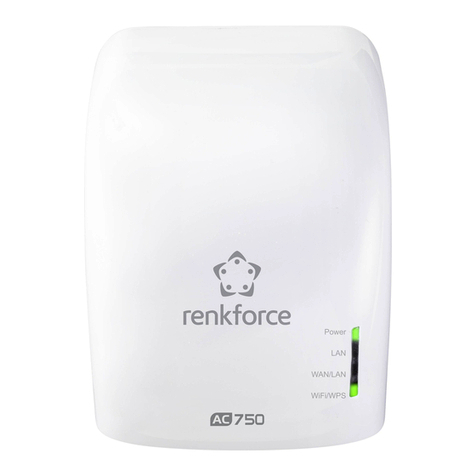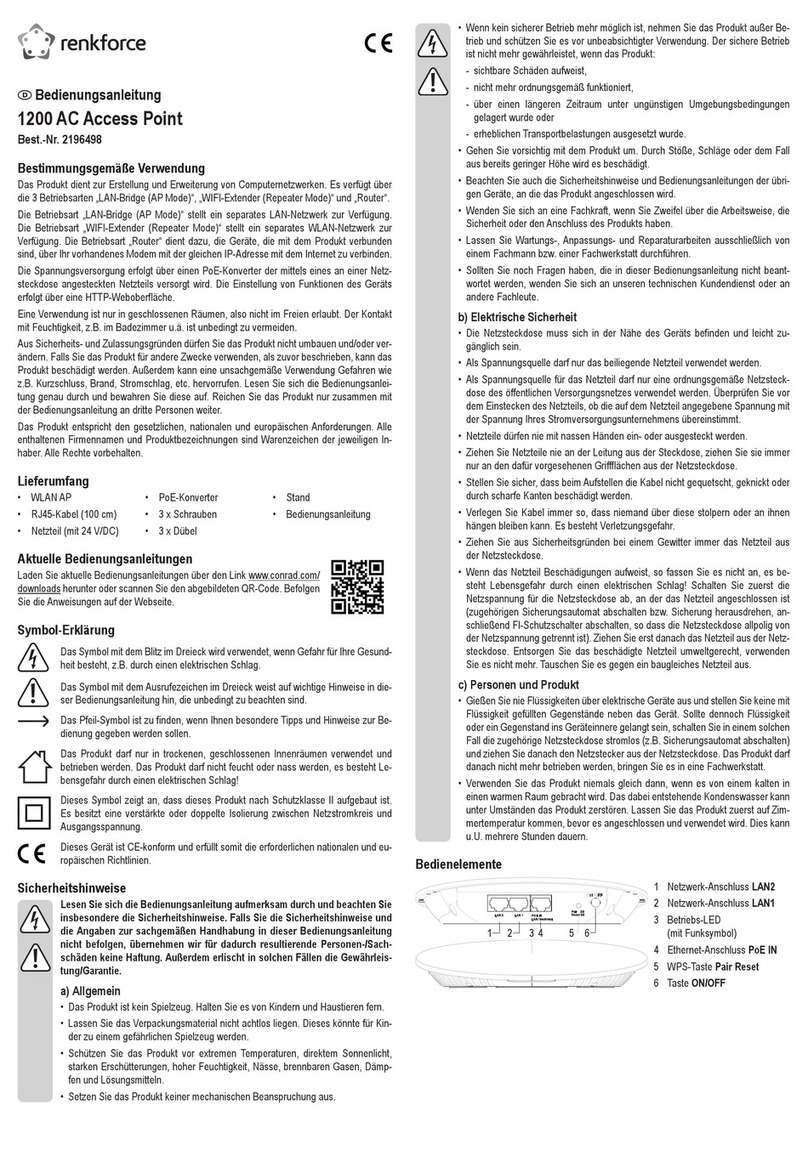
• Cliquez d’abord sur le petit cercle vide (voir
la èche dans l’image).
• Saisissez les données comme indiqué sur
l’image.
• Le dernier bloc de l’adresse IP est exible et
peut se situer entre 1 et 252. Le reste doit
être saisi exactement comme sur l’image.
La « passerelle standard » est également
l’adresse IP de l’AP.
• Conrmez en cliquant sur « OK ».
En cas de problème avec la conne-
xion, vous devez d’abord ajouter une adresse IP xe à l’interface LAN/WLAN, puis
établir la connexion.
c) Préparation de la conguration avec un iPad
• Etablissez la connexion WLAM à l’AP.
• Pendant que le WLAN est encore conguré, tapez sur la connexion WLAN, à droite sur
l’icône d’information bleue.
• Faire déler vers le bas jusqu’à la conguration IP.
• Tapez sur le point congurer l’IP et choisissez « Manuel ».
• Saisissez une adresse IP, etc., (voir la dernière image dans le chapitre précédent). La « Stan-
dardgateway/passerelle par défaut » s’appelle ici « Router/Routeur ».
• Tapez en haut à droite sur Sauvegarder et choisissez de revenir à WLAM dans la fenêtre
suivante.
• La connexion est établie.
d) Préparation de la conguration avec un Smartphone AndroidTM
• Sur votre Smatphone ouvrez les paramètres WLAN.
• Pour établir la connexion, tapez sur le WLAN de l’AP.
• Entrez le mot de passe du WLAN et cochez la case en dessous pour voir les paramètres
avancés.
• Tapez sur le point pour les paramètres IP et sélectionnez « Statique ».
• Saisissez une adresse IP, etc., (voir la dernière image dans le chapitre précédent). Au lieu du
« 255.255.255.0 » il se peut que vous n’ayez à saisir que « 24 ».
• Cliquez sur le bouton pour vous connecter.
e) Inscription sur l’interface Internet
• Une fois la connexion établie, ouvrez votre navigateur web.
• Tapez dans la barre d’adresses « http://192.168.188.253/ » (sans guillemets) et conrmez.
En cas de problème avec la présentation sur votre tablette ou iPad, tournez
l’appareil au format horizontal.
• Donnez le mot de passe « admin », et conrmez l’inscription.
• Maintenant vous devez voir la page d’accueil de l’interface Internet.
Conguration
a) Conguration de base (tous les modes d’exploitation)
• Dès que vous voyez l’interface Internet, sélectionnez d’abord le bon fuseau horaire.
Cliquez à gauche sur « Manage » puis en haut sur « Time Manager ».
Choisissez votre fuseau horaire dans le menu et conrmez en cliquant sur « Apply ».
• Ensuite dénissez la bonne région pour le WLAN.
Puis cliquez à gauche sur « WiFi » puis en haut sur « Advanced ».
Dans le menu choisissez la région « ETSI » pour l’Europe et conrmez en cliquant sur « Ap-
ply ».
• Modiez maintenant le mot de passe pour accéder à l’interface Internet.
Cliquez sur le bouton vert ci-dessus avec les 4 carrés, puis sélectionnez le bouton ci-dessous
avec l’icône de sécurité.
Saisissez d’abord l’ancien mot de passe (lors de la livraison « admin » sans guillemets),
puis entrez deux fois le nouveau mot de passe. Il devrait avoir au moins 8 caractères, et être
composé de chiffres ainsi que de lettres majuscules et minuscules.
Conrmez avec le bouton « Save ».
Si vous souhaitez réouvrir l’interface Internet après la conguration de base, vous ne devez
pas saisir le mot de passe par défaut comme mot de passe de connexion, mais le nouveau
mot de passe que vous avez attribué.
b) Conguration des réseaux WLAN (tous modes d’exploitation)
• Vous pouvez congurer les deux réseaux WLAN plus tard pendant l’assistant de congurati-
on ou directement lors du réglage. Pour ce faire, cliquez sur « WiFi ».
• Vous pouvez maintenant changer le nom des WLAN de 2,4 GHz et ajuster les paramètres.
En outre, vous devez dans tous les cas changer le mot de passe pour le WLAN. Il doit avoir
au moins 8 caractères, et devrait être composé de chiffres ainsi que de lettres majuscules
et minuscules.
• Si votre plafond est en bois par exemple, vous pouvez mettre les vis directement, sans che-
ville. Le cas échéant, il est recommandé de percer tout de même les trous..
Veillez à ne pas endommager les câbles ou conduites existants en perçant les trous
de montage ou en vissant l‘appareil.
b) Raccordement et montage de l’appareil
• Avant de mettre l’appareil dans le support de plafond, tous les
câbles nécessaires doivent encore être branchés.
• Raccordez le port « WAN/POE » (F) avec un câble réseau
1:1 (compatible avec le PoE) au port « POE » sur le bloc
d’alimentation PoE.
• Insérez l’appareil dans le support de plafond.
Pour ce faire, insérez les 4 boulons de xation de l’appareil
dans les 4 trous du support de plafond et poussez l’appareil
loin des lignes de raccordement jusqu’à ce qu’il s’enclenche.
• Connectez le port « LAN » du bloc d’alimentation PoE avec un
câble réseau 1:1 connecté à un port libre de votre routeur, commutateur réseau ou modem
(en fonction du mode d’exploitation souhaité).
• Connectez le câble d’alimentation ci-joint à la prise correspondante sur le bloc d’alimentation
PoE et insérez l’autre extrémité dans une prise secteur.
Normalement, au plafond, où un point d’accès est installé, il n’y a que le câble ré-
seau. Le bloc d’alimentation PoE est généralement connecté à proximité du routeur,
du commutateur réseau ou du modem.
Si vous disposez d’un commutateur réseau compatible avec le PoE et supportant
48 V (avec une puissance sufsante), vous pouvez également connecter l’appareil
directement au commutateur, sans alimentation PoE. Consultez le mode d’emploi
de votre commutateur réseau.
Préparation à la conguration
La conguration des AP (Points d’accès) peut être effectuée avec un PC (ordinateur,
portable, MAC) ou une tablette/smartphone. Elle peut se faire sans l via le WLAN
ou via le port LAN de l’AP.
En raison de la taille de l’image, il est toutefois recommandé de ne pas effectuer la
conguration avec un smartphone.
Dans la suite du mode d’emploi, nous n’utiliserons plus que les termes « AP » (ce
qui signie le produit et les point d‘accès), « PC » (employé pour les ordinateurs,
portables, MAC, etc..), « Tablette » (utilisé pour les tablettes et les smartphones,
quelque soit le fabricant/système d’exploitation) et « iPads » (désignant les iPads et
les iPhones).
Peu importe que vous effectuiez la conguration avec un PC ou un smartphone,
vous devez toujours associer une adresse IP xe à la connexion lors de la première
conguration.
a) Informations générales
• WLAN - Nom : « Wireless 2.4G_XXXXXX » / « Wireless 5.8G_XXXXXX » (sans guillemets
; XXXXXX représente un numéro individuel unique pour chaque appareil)
WLAN - Mot de passe : « 66666666 » (sans guillemets)
• IP - Adresse des AP : 192 168 133 253
Masque de sous-réseau : 255 255 255.0
• Interface Internet : http://192.168.188.253/
Login - Mot de passe : « admin » (sans guillemets)
b) Préparation de la conguration avec Windows 10®
• Si vous souhaitez effectuer la conguration par câble, connectez le port « LAN » de l’AP
directement au port LAN de votre PC.
• Si vous souhaitez effectuer la conguration sans l via le WLAN, connectez votre PC au
WLAN de l’AP.
• Pour assigner une adresse IP xe à la connexion (LAN ou WLAN), vous devez modier les
propriétés de l’interface correspondante. Sous Windows 10® il existe différentes possibilités
de le faire.
• Le plus simple est d’appuyer sur la touche « Windows + R » pour exécuter une commande.
Sinon, cliquez avec le bouton droit de la souris sur l’icône Windows et sélectionnez le point
« Exécuter ».
• Entrez la commande « ncpa.cpl » et cliquez OK.
• Une fenêtre s’ouvre dans laquelle vous voyez
toutes les connexions réseau de votre PC. Cli-
quez ici avec le bouton droit de la souris sur la
connexion correspondante et sélectionnez
le point « Propriétés ».
• Cliquez sur le point marqué « ...(TCP/
IPv4) » et ensuite sur « propriétés ».






























